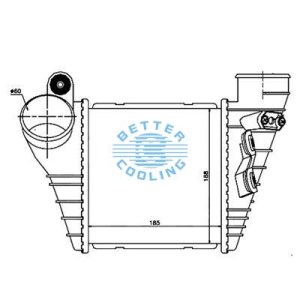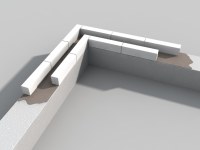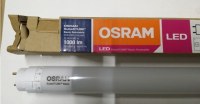Intercooler
Intercoolers are generally only visible when a turbocharged car is installed. Because the intercooler is actually a turbocharged accessory, its function is to improve the engine's ventilation efficiency. For supercharged engines, the intercooler is an important component of the booster system. Whether it is a supercharged engine or a turbocharged engine, an intercooler needs to be installed between the supercharger and the engine intake manifold. Since this radiator is located between the engine and the supercharger, it is also called intercooler.
Working principle of Intercooler
By using a well-designed intercooler can get an extra 5% - 10% power.
There are also some cars that use overhead air coolers to obtain cooling air through the openings in the bonnet, so before the car starts, the intercooler will only be blown by some hot air blown from the engine compartment, although the heat dissipation efficiency It is affected, but because the intake air temperature will rise under such circumstances, the engine's fuel consumption will drop a lot, which indirectly reduces the engine's working efficiency, but for a powerful supercharged car, it is too large. The power-induced start-up instability will be mitigated in this case, and Subaru Subaru's Impreza is typical of overhead intercoolers. In addition, the biggest advantage of the overhead intercooler layout is that it can effectively shorten the stroke of compressed gas reaching the engine.
The reasons why an intercooler is in need
One of the reasons why a turbocharged engine has more power than a normal engine is that its ventilation efficiency is higher than that of a normal engine. When the air enters the turbocharger, its temperature will rise sharply and the density will increase accordingly. The intercooler acts as a cooling air. The high temperature air is cooled by the intercooler and then enters the engine. If the intercooler is lacking and the pressurized high-temperature air enters the engine directly, the engine may be damaged or even dead due to excessive air temperature.
Since the temperature of the exhaust gas discharged from the engine is very high, the heat transfer through the supercharger increases the temperature of the intake air. Moreover, the density of the air increases during the process of being compressed, which inevitably leads to an increase in the temperature of the air, thereby affecting the charging efficiency of the engine. If you want to further increase the charging efficiency, you should lower the intake air temperature. According to the data, the engine power can be increased by 3% to 5% for every 10 °C decrease in the temperature of the charge air under the same air-fuel ratio.
If the uncooled charge air enters the combustion chamber, it will affect the engine's charging efficiency, and it will easily lead to excessive engine combustion temperature, causing knocking and other faults, and increase the NOx content in the engine exhaust gas, resulting in air. Pollution. In order to solve the adverse effects caused by the warmed air temperature, it is necessary to install an intercooler to reduce the intake air temperature.
Maintenance method of Intercooler:
The air-cooled intercooler is installed together with the intercooler radiator
of the water tank, and is installed in front of the engine, and is cooled by the suction fan and the surface wind driven by the automobile. If the intercooler is poorly cooled, the engine power is insufficient and the fuel consumption is increased. The intercooler should be inspected and maintained regularly. The main contents are: external cleaning (on the car cleaning method):
Since the intercooler is installed at the forefront, the intercooler fin passage is often blocked by leaves, sludge (hydraulic oil that is spilled into the tank), and the intercooler is blocked from heat, so it should be cleaned regularly. The cleaning method is to use a water gun with a low pressure to hang down from the top to the bottom or from the bottom to the bottom of the intercooler, but never slant to prevent damage to the intercooler. Internal cleaning, inspection (demolition cleaning method):
The internal of the intercooler are often accompanied by dirt such as sludge and colloid, which not only narrows the air flow passage, but also reduces the cooling heat exchange capacity. Therefore, maintenance and cleaning must also be performed. - The interior of the intercooler should be cleaned and inspected at the same time as the engine is overhauled and the tank is repaired.
Location : 35 Huashan Road, Gaochun Economic Development Zone, Nanjing , 211300 Nanjing ,
Contact : Wei Jiang , +86 25 52129310







